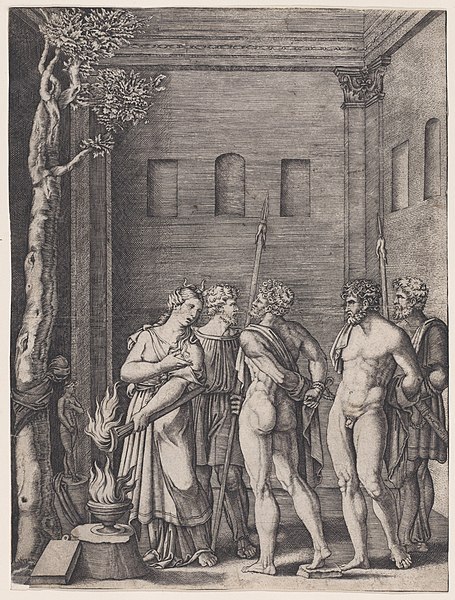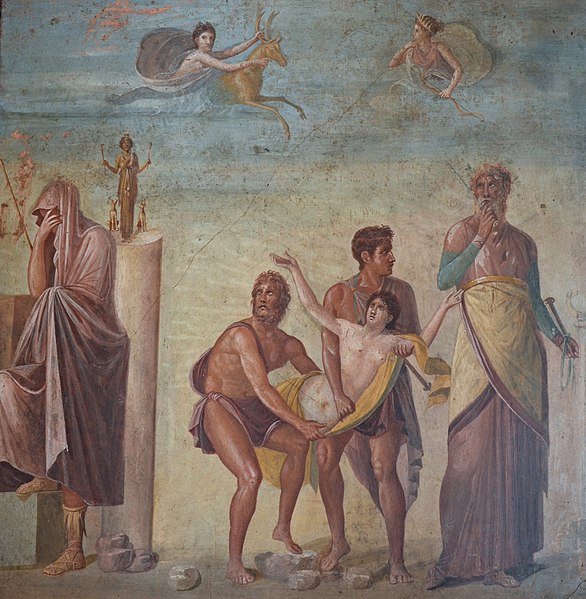Iphigenia is a figure whose narrative is as tragic as it is inspiring. Her tale is one of sacrifice, love, and the intricate webs of family ties.
Iphigenia Key Facts
| Parents | Agamemnon and Clytemnestra |
| Partners | None |
| Siblings | Orestes and Electra |
| Offspring | None |
| Other names | Iphianassa |
| Roman name | Iphigenia |
| Best Known Myth | Sacrifice at Aulis |
Name and Etymology
The name “Iphigenia” is believed to mean “strong-born” or “born to strength” in ancient Greek.
The Romans, ever the admirers of Greek culture, adopted many of their myths, including Iphigenia’s. However, they kept her name largely unchanged. Throughout various texts and tales, she’s also occasionally referred to as Iphianassa, an epithet that further emphasizes her royal lineage and significance.

Iphigenia’s Family and Relationships
Born to Agamemnon, the king of Mycenae, and his queen, Clytemnestra, Iphigenia’s lineage was nothing short of royal. She had two siblings: Orestes and Electra, both of whom played significant roles in the larger tapestry of Greek myths.
The looming shadow of the Trojan War marked Iphigenia’s childhood. Regarding love interests, few tales recount Iphigenia’s romantic escapades. Nevertheless, her story intertwines deeply with her family’s relationships and conflicts, especially with her father, Agamemnon.
Myths about Iphigenia
Iphigenia’s narrative is a tapestry of emotions, sacrifice, and divine interventions. Her myths not only highlight her personal journey but also showcase the intricate dynamics of the Trojan War and the lengths to which individuals would go for honor and duty.
Sacrifice at Aulis
The most renowned tale of Iphigenia is undoubtedly her sacrifice at Aulis. As the Greek fleet prepared to set sail for Troy, they found themselves stranded due to the absence of favorable winds. Calchas, a seer, revealed that the winds were stilled by the goddess Artemis, angered by Agamemnon. The only way to appease her and gain favorable winds for their journey was a heart-wrenching one: Agamemnon had to sacrifice his beloved daughter, Iphigenia.
Torn between his duty as a leader and his role as a father, Agamemnon faced an impossible choice. Deception played a part, as Iphigenia was lured to Aulis under the pretense of marrying Achilles. As she was led to the altar, some versions of the myth suggest that Artemis, moved by Iphigenia’s bravery and innocence, replaced her with a deer, whisking the maiden away to Tauris where she became a priestess.
Iphigenia in Tauris
Following the events at Aulis, certain myths propose that Artemis transported Iphigenia to Tauris (modern-day Crimea) instead of meeting her demise. There, she transitioned into a role of a priestess in a temple devoted to the goddess. The intriguing twist? The local custom dictated the sacrifice of any Greek strangers to Artemis.
The narrative takes another turn when her brother, Orestes, and his friend Pylades arrive in Tauris, sent on a mission by Apollo. Unbeknownst to Iphigenia, she was to perform the sacrifice of her own brother. However, upon recognizing each other, the siblings devised a plan to escape together, stealing a statue of Artemis that was key to the success of their mission.
Depiction And Characteristics
Iphigenia is often depicted as a young maiden, sometimes with a deer (a nod to her association with Artemis and her near-sacrifice). She embodies innocence, bravery, and the tragic weight of destiny. Symbols associated with her often include the sacrificial altar and the aforementioned deer.
Her personality, as gleaned from myths, paints a picture of a dutiful daughter, torn between her love for her family and the cruel hand of fate. The Ancient Greeks viewed her as a symbol of sacrifice and the often tragic interplay between duty and family.
Representations Of Iphigenia In Art
Throughout history, Iphigenia’s tragic tale has moved many an artist. From ancient pottery depicting her near-sacrifice to Renaissance paintings showcasing her moments with Artemis, her story has been a source of inspiration. One of the most famous artworks is “The Sacrifice of Iphigenia” by Giovanni Battista Tiepolo, where the raw emotions of the moment are beautifully captured.

Mentions in Ancient Texts
“Iphigenia at Aulis” by Euripides
Euripides, a playwright from the 5th century BC and one of the three great tragedians of classical Athens, penned “Iphigenia at Aulis.” This play delves deep into the emotional turmoil surrounding Iphigenia’s sacrifice. A notable quote from the play reads: “Death in a noble cause is honor, not death at all.”
“Agamemnon” by Aeschylus
Aeschylus, another of the famed Athenian tragedians from the early 5th century BC, wrote “Agamemnon,” the first play in his trilogy, “The Oresteia.” The play touches upon the aftermath of Iphigenia’s sacrifice and the vengeance of her mother, Clytemnestra. A poignant line from the play states: “Blood for blood, and through blood, peace.”
“Electra” by Sophocles
Sophocles, the third of the great Athenian playwrights from the 5th century BC, wrote “Electra.” This play focuses on Iphigenia’s sister, Electra, and her thirst for revenge after the death of their father, Agamemnon. While Iphigenia’s direct presence is minimal, her sacrifice’s shadow looms large over the narrative. Furthermore underscoring the tragic cycle of the family’s fate.
Frequently Asked Questions
It was an effort to appease Artmeis and ensure the Greek fleet could sail to Troy.
Not prominently. Her story focuses more on her familial ties and the Trojan War.
Her sacrifice was a pivotal event that allowed the Greek fleet to sail to Troy, marking the beginning of the war.
Featured Image Credit: Pierre Biard II, CC0 1.0, via Wikimedia Commons
